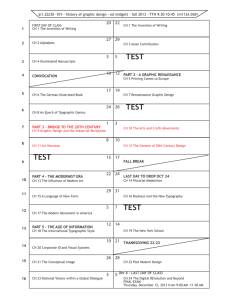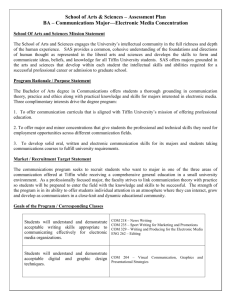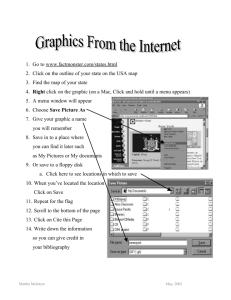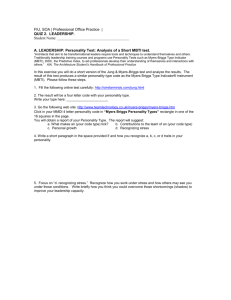Profile of the Learning Style of Students Taking - ASEE
advertisement
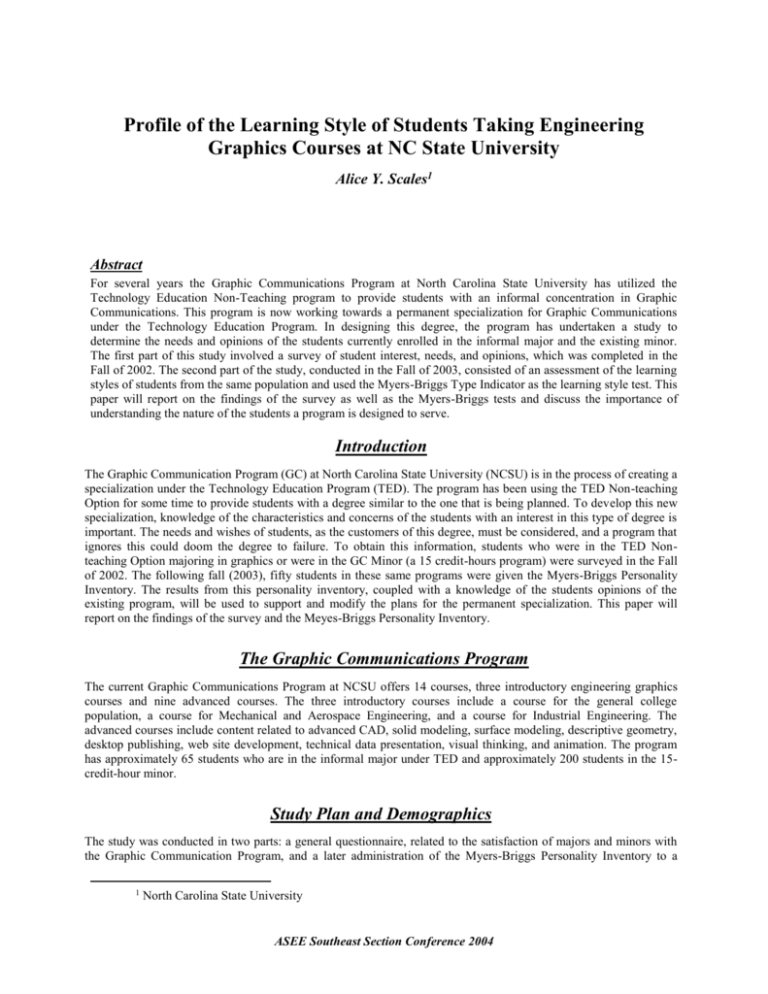
Profile of the Learning Style of Students Taking Engineering Graphics Courses at NC State University Alice Y. Scales1 Abstract For several years the Graphic Communications Program at North Carolina State University has utilized the Technology Education Non-Teaching program to provide students with an informal concentration in Graphic Communications. This program is now working towards a permanent specialization for Graphic Communications under the Technology Education Program. In designing this degree, the program has undertaken a study to determine the needs and opinions of the students currently enrolled in the informal major and the existing minor. The first part of this study involved a survey of student interest, needs, and opinions, which was completed in the Fall of 2002. The second part of the study, conducted in the Fall of 2003, consisted of an assessment of the learning styles of students from the same population and used the Myers-Briggs Type Indicator as the learning style test. This paper will report on the findings of the survey as well as the Myers-Briggs tests and discuss the importance of understanding the nature of the students a program is designed to serve. Introduction The Graphic Communication Program (GC) at North Carolina State University (NCSU) is in the process of creating a specialization under the Technology Education Program (TED). The program has been using the TED Non-teaching Option for some time to provide students with a degree similar to the one that is being planned. To develop this new specialization, knowledge of the characteristics and concerns of the students with an interest in this type of degree is important. The needs and wishes of students, as the customers of this degree, must be considered, and a program that ignores this could doom the degree to failure. To obtain this information, students who were in the TED Nonteaching Option majoring in graphics or were in the GC Minor (a 15 credit-hours program) were surveyed in the Fall of 2002. The following fall (2003), fifty students in these same programs were given the Myers-Briggs Personality Inventory. The results from this personality inventory, coupled with a knowledge of the students opinions of the existing program, will be used to support and modify the plans for the permanent specialization. This paper will report on the findings of the survey and the Meyes-Briggs Personality Inventory. The Graphic Communications Program The current Graphic Communications Program at NCSU offers 14 courses, three introductory engineering graphics courses and nine advanced courses. The three introductory courses include a course for the general college population, a course for Mechanical and Aerospace Engineering, and a course for Industrial Engineering. The advanced courses include content related to advanced CAD, solid modeling, surface modeling, descriptive geometry, desktop publishing, web site development, technical data presentation, visual thinking, and animation. The program has approximately 65 students who are in the informal major under TED and approximately 200 students in the 15credit-hour minor. Study Plan and Demographics The study was conducted in two parts: a general questionnaire, related to the satisfaction of majors and minors with the Graphic Communication Program, and a later administration of the Myers-Briggs Personality Inventory to a 1 North Carolina State University ASEE Southeast Section Conference 2004 sample from the same population. The first part of the study was completed during the Fall Semester of 2002, and the second part of the study in the Fall of 2003. The survey consisted of 20 questions plus demographic information. Questions related to the following: areas of course work satisfaction and dissatisfaction, computer programs taught by the GC Program, reasons for entering the program, ways of hearing about the program, previous experience in field of study, courses taken in the TED Program, and future plans after graduating. Instructors of advanced Graphic Communications courses administered the survey to appropriate students. A total of 56 students participated in the first part of the study, 13 females and 43 males. Of these, 18 were majors in Graphic Communications through the TED Non-Teaching Option, and 38 were minors in the program. The students who completed the survey had taken between one and seven GC courses. With the exception of two, all of the respondents had completed high school in North Carolina. Their ages ranged from 19 to 47, with a mean age of 22.2 and median age of 22. Forty-five were White, four were African American, three were Hispanic, two were Native American, and two were Oriental. The respondents’ average Grade Point Average (GPA) was 2.83 with a median GPA of 2.8 (SD=.43). The majority of the students in the minor program were majoring in some field of engineering. The majors were predominately individuals who begin in an engineering program and transferred from there to Graphic Communications. For the Myers-Briggs Personality Inventory portion of the study, students enrolled in the upper level courses were again selected. The researcher attended each of the advanced courses offered that semester in the Graphic Communications Program and asked students who were enrolled in the major and minor to complete the inventory. For this part of the study, a total of 50 students (33 minors and 17 majors) participated. This sample consisted of 13 females and 37 males with a mean age of 22.64 years, a range of ages from 19 to 56, and a median age of 22. These students had taken between one and thirteen courses in the Graphic Communications program. Survey Results Program Satisfaction Answers to the survey questions related to the level of student satisfaction with the program and the reasons for this satisfaction were revealing. Of the 55 students who completed this portion of the questionnaire, all of them stated that they would recommend this program to another student. When asked what they liked about the program, 19 out of 53 (35%), indicated that the faculty was their favorite thing about the program, 14 (26%) liked the hands-on nature of the curriculum, and 12 (22%) like some aspect of the course content. When asked what changes the survey respondents would make in the Graphic Communications Program, the most common suggestion was to increase the number of classes and sections offered. Fourteen students out of 44 (32%) listed this, and 12 (27%) suggested that more software instruction be added. This second suggestion was unexpected, since only 11% of the respondents indicated that software instruction was the reason they liked the program. The third largest suggestion (7 or 11%) was that nothing be changed. On the survey, students were asked to indicate the courses they had previously taken in the GC Program and to rank order them, beginning with the number one (1), to indicate the order of their enjoyment of these courses. To examine these responses, a subset of the original respondents was created to examine only those students who had taken four or more GC courses. Twenty-one of the 56 respondents met this criterion. When examining the data from this subset, the analysis revealed that students listed GC 410, Concepts of Desktop Publishing, and GC 420, Visual Thinking, equally as their favorite course. A tie also occurred for the second most commonly listed choice for favorite class, which was between GC 496N, Introduction to Technical Animation, and GC 350, Applied CAD/D and Geometric Controls. When analyzing the data for respondents' selection of their second most favorite course, GC 350, Applied CAD/D and Geometric Controls, received the largest number of listings. For the next most listed as the second favorite ASEE Southeast Section Conference 2004 course, a three way tie occurred among GC 496N, Introduction to Animation; GC 420, Visual Thinking; and GC 496O, Surface Modeling. Software When respondents were asked their preferences for software taught as part of the courses in the GC program, the largest number, 22 out of 55 (40%), indicated that their favorite software was Solidworks, a constraint-based solid modeling program. AutoCAD was listed second (14 or 25%), and 3D Studio Max was listed third (8 or 15%). When asked which software was the most difficult to learn, 15 (28%), of the 53 students who responded to the question, indicated AutoCAD, and 10 students (18.8%) indicated none. When examining the data from the subset of respondents who had completed four or more courses in the GC Program, the favorite software was tied between Solidworks and 3D Studio Max (7 or 33%). The analysis of the data from this group also produced a tie for the most difficult software to learn, 3D Studio Max and AutoCAD (4 or 20%); however, the software packages they listed were also more diverse. Gender A comparison of responses by gender found some differences between the males and females. When examining the reasons individuals gave for liking the program, the females’ most common answer was the hands-on nature of the program, followed by the faculty. None of the females, not surprisingly, listed software instruction as a reason for enrolling in the program. Based on findings in other studies related to attitudes towards computers and gender, males were found to have a stronger positive attitude towards computers when compared to their female counterparts. 1,2,3 When asked about improvement to the program, females and males again differed slightly. The 34 males who made recommendations on the survey indicated equally that it would be improved by an increase in additional classes and sections and more software instruction (29.4%); however, of the 10 females who answered this question, 50% recommended more sections and 30% an increase in software instruction. Minors and Majors A comparison of the subsets of students who were majoring and minoring in the program also revealed some differences. The biggest difference found between these groups was in GPA. Overall, the minors had a higher mean GPA than the majors. The mean GPA for the majors was 2.68 and the mean for the minors was 2.91. This was not unexpected. The students enrolled in the major are predominately individuals who did poorly in other fields of study and then transferred into the program. This can be seen when comparing the transfer mean of each group of students. The average number of program transfers made by the minor students was 1.26. The majors, however, averaged 1.88 program transfers. Another difference found between these groups was the reasons they gave for liking the program. Over half (53%) of the students majoring in the program listed the faculty as their favorite thing about the program. Minors, on the other hand, gave more diverse reasons. Their most frequently reported reasons for entering the program were the course content (31%), the faculty (27.7%), and the hands-on nature of the course work (27.7%). This was an interesting finding and may indicate that students who major in this field are looking for a program where instructors pay them more attention. Most of the students transferring into the GC program were from large programs in engineering and frequently commented on the amount of time and attention they receive from the instructors in the Graphic Communications Program. Still another difference between the groups was the way in which they had heard about the Graphic Communications Program. The minors became aware of the program predominately when they took an introductory GC course (61%). The majors, however, found out about the program in diverse ways. Twenty-eight percent heard about it from other students, 22% through the Freshman College, 11% from a faculty member, and 11% through a major fair. There is also a great deal that these groups have in common, as would be expected. Examination of their prior drafting experience finds them to be almost identical. Sixty-six percent of the majors and 65% of the minors took drafting previously in high school. Compared to the percentage of prior drafting experience reported in introductory ASEE Southeast Section Conference 2004 GC classes, this is somewhat high. In a previous study conducted by the author, 50% of these students reported they had prior drafting experience.4 This could indicate a predisposition of individuals who have taken courses in high school to be more attracted to this field of study. Myers-Briggs Personality Inventory For the second part of this study, the Myers-Briggs Personality Inventory was administered to 50 students who also were either minoring or majoring in the Graphic Communications Program. The Myers-Briggs Personality Inventory is one of many tests for determining learning styles. There is considerable evidence that understanding the learning styles of students aids in designing instruction.5 The Myers-Briggs instrument is based on Carl Jung's concept of personality types. According the Consulting Psychologists Press, Inc. (CPP), who owns and sells the instrument, approximately 2,000,000 individuals take this test every year. This test determines which of four pairs of personality characteristics individuals exhibit. The pairs of characteristics consist of: Extraversion/Introversion, Sensing/Intuition, Thinking/Feeling, and Judging/Perceptive. 6 Individuals who are extraverted are expressive, outgoing, and are energized by action, people, things. Introverts, on the other hand, are quiet, shy, and energized by ideas, feelings, and impressions. Sensors focus on the physical world and live by their five senses. Intuitives, however, are focused on the mental and spiritual world. Thinkers value truth and use logic in making decisions. Feelers, by comparison, value harmony and use personal feelings in making decisions. Judgers are decisive, and make decisions quickly and firmly. Perceivers, the opposite of judgers, adapt to situations, and gather more information before deciding. 7 According to CPP, one characteristic from each of these four pairs generally dominates individuals, although some individuals may exhibit characteristics to some degree of both. No individual is wholly one or the other.6 Myers-Briggs Inventory Results In examining the data from the Myers-Briggs Inventory, a slight trend in personality types was observed. However, none of these trends were statistically significant. The analysis of the total respondents found that under the category Introvert/Extravert, 56% of the students surveyed were extraverts, 38% were introverts, and 6% exhibited some characteristics of both. Under the category of Sensing/Intuitive, 54% were intuitive, 40% were sensing, and 6% again demonstrated some of the characteristics of each. In the third category Thinking/Feeling, 54% were thinkers, 34% were feelers, and 12% exhibited characteristics of both. Under the category of Judging/Perceiving, 56% were perceivers, 38% were judgers, and again 6% fell between the two. The data indicate that there was no clear personality type observed in this sample, and the same approximate percentages were observed when examining the minors and majors separately. There was a slight difference found, however, between the males (N=37) and females (N=17) in the sample. Again, the number was too small to find any significance. The females in the sample were almost exactly split between extraverts and introverts. The group of males, on the other hand, had more extraverts. A larger percentage of females exhibited sensing characteristics, but their male counterparts were almost equally split between the sensing and intuition. Under the category of Thinking/Feeling, males were predominately thinkers, and females were predominately feelers. Under Judging/Perceiving the females were again equally split and the males were dominantly judgers. Conclusions In examining the data, it is obvious that the current Graphic Communications Program works fairly well for most of the students who are enrolled in the minor or the major. All of the respondents stated that they would recommend the program to other students, and many indicated that they liked the instructors in the program. Most complaints were centered on the lack of classes and class sections. The students surveyed also indicated their desire for an increase in software instruction. The need for additional sections is a legitimate complaint. Due to a lack of instructors, the number of upper level courses taught by the program is restricted, leaving these students to fight to get into classes. This survey provides evidence that a problem exists and can possibly be used to push the administration to rectify the situation. The suggestion that the courses include more software instruction leads the author to the conclusion that the ASEE Southeast Section Conference 2004 instructors in the program are not doing a sufficient job in informing students of the importance of understanding the basics of graphics that the courses cover. For better or worse, students perceive software instruction to be the center of the program, and, although it helps attract students to the program, its relationship to the core content of the courses should be keep in perspective. If students are unable to see this, then the faculty teaching the courses should address it. Another observation that can be gleaned from the data is that students who have taken a large number of courses in the program seemed to enjoy most the courses that involve some creativity. These courses were Visual Thinking, Desktop Publishing, and Animation. This result probably can be attributed to the large number of minor students in the sample. Since the majority of these students are in some program in engineering, they may enjoy a change from the technical courses they take as part of engineering; however, this finding could also indicate that students find these courses a direct complement to their studies in engineering design. The issue of software preference was also interesting. Since the program changed to Solidworks from AutoCAD as its primary program in the introductory and some advanced courses, a debate over which program is better for preparing students for their careers after leaving the university has occurred in a number of faculty meetings. The data analysis provides evidence that both software programs are liked by students, but the majority of them prefer Solidworks. One reason for using Solidworks is that it is easier to convey the graphical concepts of the course. Although this may not be an indication that Solidworks is the best program to teach, it does indicate that students have embraced this change. The results of this survey have implications for teaching, recruiting, and keeping students in the new major. In the area of teaching, student interest can become the center of projects in courses and allows instructors to acknowledge the preferences of students even when it is inappropriate to adhere to them. Fortunately, the majority of students voiced satisfaction with the program, particularly with the faculty. Although faculty in the Graphic Communications Program have always dedicated considerable time to students, the survey results imply that the time faculty spend with students is valued by them. In recruiting students for this major, the personal attention paid to students should, likewise, be highlighted. This is particularly true for students currently enrolled in engineering programs that are looking for a new major. The data likewise indicate that the program should have more of a presence at university career fairs, Freshman College events, and high school career fairs, since these seem to be the main source of majors for the program. In particular, high school students who have taken drafting in high school are a large potential source of majors for this program and should be courted by it before they enter college. Knowing the learning styles of the students in the program also provides some meaningful information. First, it demonstrates that there is no clear learning style that predominates in the students in the program, which means that the faculty must continue to provide a variety of learning experiences that are appropriate for all student learning styles. Second, it indicates that students in the program find a niche they feel comfortable with, regardless of their personality type. This may be due to the diversity of technical graphics provided by the program. These areas include hard edge graphics, such as CAD, as well as courses in the creative side of technical graphics, such as desktop publishing, animation, and web site development. The next phase of this study will be to examine the needs of potential employers of graduates from this program as well as determine how well the current program has met the needs of former graduates in the workplace. This will allow the program to be further defined and tuned to provide the optimum educational experience for our students. References 1. Arch, E. C. & Cummins, D. E. (1989). Structured and unstructured exposure to computers: Sex differences in attitude and use among college students. Sex Roles, 20 (5/6), 245-254. 2. Fetler, M. (1985). Sex differences on the California statewide assessment of computer literacy. Sex Roles, 13 (3/4), 11-20. 3. Francis, L. J. (1994). The relationship between computer related attitudes and gender stereotyping of computer use. Computers in Education, 22 (4), 283-289. ASEE Southeast Section Conference 2004 4. Scales, A. Y. (2000). The effect of learning style, major, and gender on learning computer-aided drawing in an introductory engineering/technical graphics course. An unpublished dissertation, North Carolina State University. 5. Curry, L. (April, 1983). An organization of learning styles theory and constructs. Paper presented at the Annual Meeting of the American Educational Research Association, Montreal, Quebec. 6. Brightman, H.J. GSU Master Teacher Program: On Learning Styles. Improving University-Level Teaching and Learning. (An Online Training Program at Georgia State University) http://www.gsu.edu/~dschjb/wwwmbti.html 7. Hirsh, S.K. and Kummerow, J.M. (1990). Introduction to type in organizations: individual interpretive guide. Consulting Psychological Press: Palo Alto, CA. ASEE Southeast Section Conference 2004 Alice Y. Scales Alice Y. Scales is the Assistant Department Head of the Department of Mathematics, Science, and Technology Education and Coordinator of the Graphic Communications Program at North Carolina State University. She has taught at North Carolina State University since 1988. She has a B.S. in Science Education, a M.Ed. in Industrial Arts Education, and an Ed.D. in Occupational Education. At NC State University, she teaches introductory engineering graphics courses that include CAD, desktop publishing, and web site development. ASEE Southeast Section Conference 2004
